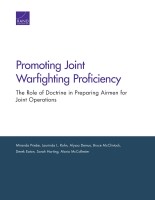| 来源类型 | Research Reports
|
| 规范类型 | 报告
|
| DOI | https://doi.org/10.7249/RR2472
|
| ISBN | 9781977400543
|
| 来源ID | RR-2472-AF
|
| Promoting Joint Warfighting Proficiency: The Role of Doctrine in Preparing Airmen for Joint Operations |
| Miranda Priebe; Laurinda L. Rohn; Alyssa Demus; Bruce McClintock; Derek Eaton; Sarah Harting; Maria McCollester
|
| 发表日期 | 2018
|
| 出版年 | 2018
|
| 页码 | 92
|
| 语种 | 英语
|
| 结论 |
Assessment of alignment and tone- Air Force doctrine presents many principles, processes, and terms that are consistent with those found in joint doctrine.
- Air Force doctrine introduces some alternate constructs from those used in joint doctrine, sometimes without noting the differences.
- Air Force doctrine offers less information on some key topics (e.g., planning processes and considerations) compared with joint doctrine.
- Some sections of Air Force doctrine displayed a highly joint tone, effectively incorporating joint context and describing the service as a unique, but not superior, contributor to joint teams.
- Some sections of Air Force doctrine were more insular, focusing primarily on service-specific issues with little discussion of the role the Air Force would play as part of a joint team.
Doctrine and joint constructs in the Air Force- Doctrine is not central to Air Force culture, so revisions to service doctrine, on their own, would only have a limited effect on airmen's joint proficiency.
- Of the limited number of airmen interviewed for this study, many reported that they do not use joint doctrine and constructs regularly throughout their careers, joint experiences often come late, and joint professional military education is often disconnected from joint experiences.
|
| 摘要 |
- The Air Force could revise its doctrine to more consistently introduce and summarize key joint constructs, use graphics to show relationships between joint and Air Force constructs, and provide more information on planning processes and considerations.
- Before the Air Force adopts these recommendations, it should consider whether some divergences should be preserved because of the unique characteristics of airpower or whether changes to joint doctrine would be more appropriate.
- Air Force leaders also need to consider potential trade-offs with other Air Force priorities, such as adopting consistent terminology across the air, space, and cyber domains.
- The Air Force could provide opportunities for airmen to use joint doctrine and constructs in practice by introducing more joint terminology into tactical publications and activities and looking for opportunities to replace Air Force–specific planning terms and processes with their joint equivalents.
- Linking formal exposure to joint doctrine with joint experience may also help airmen internalize the joint language and mindset.
|
| 主题 | Joint Operations
; Military Doctrine
; United States Air Force
|
| URL | https://www.rand.org/pubs/research_reports/RR2472.html
|
| 来源智库 | RAND Corporation (United States)
|
| 引用统计 |
|
| 资源类型 | 智库出版物
|
| 条目标识符 | http://119.78.100.153/handle/2XGU8XDN/108818
|
推荐引用方式
GB/T 7714 |
Miranda Priebe,Laurinda L. Rohn,Alyssa Demus,et al. Promoting Joint Warfighting Proficiency: The Role of Doctrine in Preparing Airmen for Joint Operations. 2018.
|
|
文件名:
|
x1534430166031.jpg
|
|
格式:
|
JPEG
|

|
文件名:
|
RAND_RR2472.pdf
|
|
格式:
|
Adobe PDF
|
除非特别说明,本系统中所有内容都受版权保护,并保留所有权利。